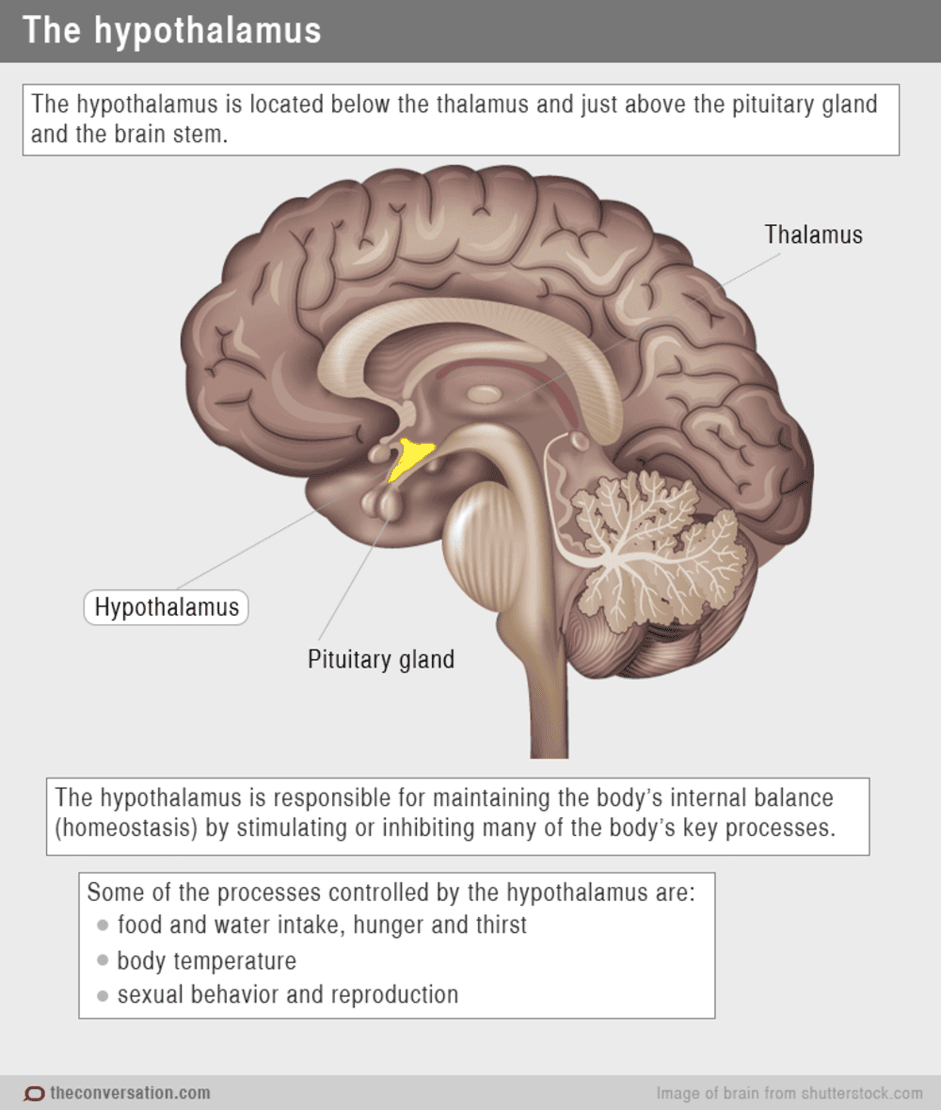HOW DOES HUNGER AND APITITE WORKS IN OUR BODY?
We all need food to survive. The need to supply food to generate energy is a driving force in the biology of all living organisms. It is more than natural for our body to have a complex system operated by our hormones in terms of control to nutrient intake.
Hormone levels change both when we gain weight and when we lose weight. Even though we try hard to change our diets and eating habits, hormonal imbalance is also the reason we regain the lost weight.
The system responsible for regulating nutrient intake in our body is the hypothalamus, positioned just behind our eyes, under the midline of our brain.

The hypothalamus is located under the thalamus, just above the pituitary gland and the brain stem.
Thalamus, hypothalamus, pituitary gland
The hypothalamus is responsible for maintaining the body's internal balance (homeostasis).
Some processes controlled by the hypothalamus
- Food and water intake, hunger and thirst
- Body temperature
- Sexual behavior and reproduction
There are nerve cells in the hypothalamus whıch, upon actıvatıon, produce the feeling of hunger. These nerve cells produce two proteins that elicit the sense of hunger: Neuropeptide Y (NPY) and agouti-associated peptide (AGRP).
Close to these nerve cells, there is another group of nerve cells that strongly suppress the feeling of hunger. These cells produce two different proteins that suppress hunger: Kocaine and amphetamine-regulating transcript (CART) and melanocyte-stimulating hormone (aMSH). These two sets of nerve cells initiate starvation signals and send these signals to other regions of the hypothalamus. Thus, your wish of eating or not eating depends on the balance of action between these two groups of neurons.
So what determines which neuron group will dominate at any moment of time?
The determinants are our hormones. These hormones are secreted from organs such as the small intestine, pancreas, which work on obtaining and storing energy.
Blood Hormones
Ghrelin: This hormone, which is produced in the stomach, enters the brain through the blood and increases the activity of the nerve cells in the hypothalamus responsible for the sense of hunger. It also reduces the activity of cells that suppress the feeling of hunger. Thus, the balance between the nerve cells that provide a feeling of hunger and satiety shifts in favor of the cells that give a feeling of hunger. As the stomach gets empty, ghrelin hormone secretion increases, while this secretion decreases as the stomach gets full.
Insulin-like peptide 5 (ILP-5): It was discovered in 2014 , as a hormone produced mainly in the large intestine, having role in arousement of the secondary feeling of hunger. But, we are not familiar in total with its physiological role, yet.
Cholecystokinin (CCK): is a hormone produced in the small intestine which gives the sense of saturation in co-relation with the nutrient intake. The moment the food reaches the small intestine, the same moment this hormon gets activated for feeling saturation. This hormone`s action has been prooved by one experiment made by a group of researchers, in which Cholecystokinin made food intake termination the same moment it was injected into the brain of an eating mouse.
Peptide YY, glucagon-like peptide 1 (GLP-1), oxintomodulin and uroguanylin: All of these hormones are produced at the end of the small intestine and give us a feeling of fullness. As soon as some food reaches the intestine, these hormones are produced in response.
Leptin: It is a very strong appetite suppressant hormone and is produced in fat cells. As the number of fat cells increases, the body produces more leptin.
Amylin, insulin and pancreas polypeptide: All these hormones are produced in the pancreas.The brain reaching Insulin reduces the feeling of hunger by causing the message in the brain " There is enough energy in the body ”. Amylin is produced by insulin-producing cells (beta cells) and has a role in food intake limitation. There are no exact facts on what the pancreas polypeptide does yet , but the so far experience implicates that it suppresses the hunger.

HORMONES THAT CONTROL OUR APPETITE
Positioning and functions of The hormones controling our apetite
Examples of hormones that control neurons in the hypothalamus and their effects on our appetite:
Pancreas Amyline Insulin Pancreas polypeptide Suppresses the hunger.
Small Intenstine (Lower Part) Peptide YY Glucagon-like peptide 1 (GLP-1) Oxytomodulin Uroguanylin Suppresses hunger.
Small Intenstine (Upper part) Cholecystokinin Suppresses hunger.
Fat Cells Leptin Suppresses Hunger
Large Intestine Insulin-like Peptide 5 Awakens the feeling of hunger.
Stomach Girelin provokes a feeling of hunger.
The hypothalamus also affects eating behavior; It also receives signals from the paths of indulgence using neurotransmitters such as dopamine, endocannabinoids and sertonin. When saturation is reached, the stomach sends a message to the hypothalamus by reducing the secretion of ghrelin, thereby reducing the desire to eat.
Ghrelin levels get low in 30 to 60 minutes after eating. The levels of CCK, PYY, GLP-1-hormon that makes us feel full, amylin and insulin are increased to its highest peak in 30 to 60 minutes after a meal. The level of all these hormones gradually decreases in the period of 3 to 4 hours after a meal.
How does weight loss affect our hormones?
Many studies have shown that diet-related weight loss is associated with changes in hormone levels. Leptin levels following weight loss get significantly reduced. Changes in other hormone levels are being noticed due to the feeling of hunger and satiety.
Almost all of these changes increase hunger, reduce satiety and increase fat storage capacity and lead the person to recover lost weight. These hormonal changes occur at least one year after weight loss, leading to a constant increase of hunger state.
Source: https://bilimfili.com/aclik-ve-tokluk-hissi-olusturan-kimyasal-mesajcilar-hormonlarimiz/



